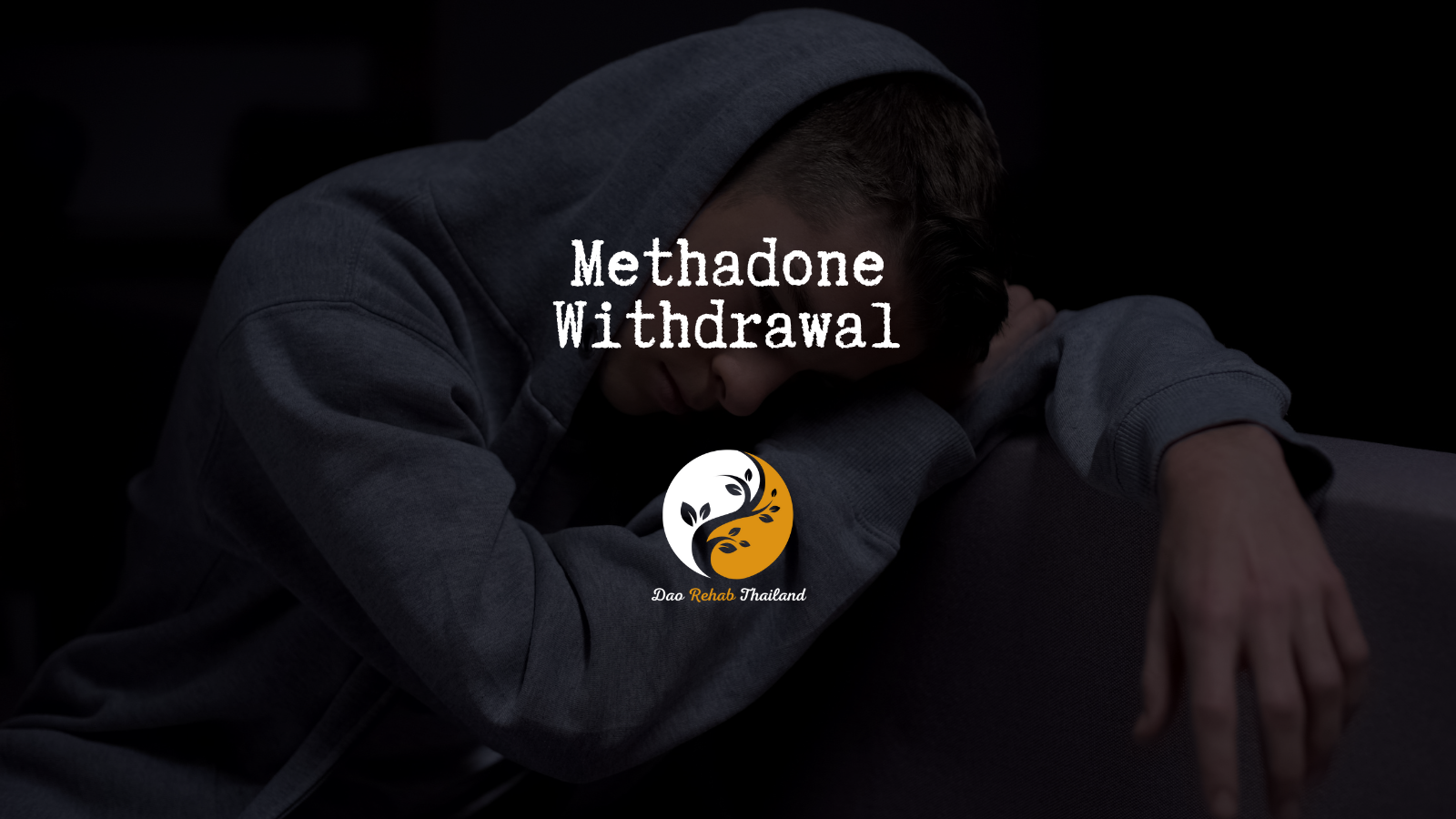
Methadone Withdrawal in thailand
Methadone Withdrawal
“Turning the impossible into possible”

"Detox from Methadone at a Luxury Holistic Center in Thailand and Israel"

Detox from Methadone
Methadone Withdrawal is a challenging process that requires professional support and gradual reduction to prevent severe withdrawal symptoms. Methadone is an opioid substitute widely used to ease withdrawal symptoms from drugs like heroin, but it can itself cause dependency.
Methadone detoxification at DaoTherapy is conducted in a supportive environment focused on holistic healing. This process includes a gradual reduction of methadone dosage, under professional supervision, to prevent severe withdrawal symptoms such as pain, anxiety, and fatigue. Patients participate in treatments such as yoga, meditation, and breathing techniques, promoting a sense of calm and enhancing self-awareness. The DaoTherapy team provides emotional support and tools to cope with challenges, fostering personal and spiritual growth. This approach not only aids in mental and physical rehabilitation but also enables patients to improve their quality of life and opens doors to profound and comprehensive healing after methadone addiction.
Methadone is a narcotic drug primarily used for chronic pain management and in opioid addiction recovery programs, such as for heroin.
"Holistic Center for Trauma, Addiction, and Mental Imbalance Treatment in Thailand"
“Come to the beginning of your journey to freedom from addiction to alcohol, drugs, and pills, and rediscover your life within the serene embrace of DaoTherapy Rehab in Thailand—where holistic healing meets empowering recovery.”
DaoTherapy Holistic Rehab
Key Elements of Methadone Detox:
Medical Supervision: Methadone detox must be conducted under medical supervision, as the body may experience withdrawal symptoms. These can include nausea, anxiety, muscle aches, and insomnia. A medical team will monitor and manage these symptoms to ensure the patient’s safety and comfort.
Holistic Therapies:
Holistic Therapies: Many detox programs incorporate holistic therapies such as mindfulness, yoga, and meditation to help individuals cope with stress and anxiety during the detox process. These therapies support the mind-body connection and contribute to overall recovery.
Tapering Process
Tapering Process: Methadone detox often involves a gradual tapering of the drug to reduce withdrawal severity. Doctors will slowly decrease the dosage over time to allow the body to adjust to lower levels of the substance.
Psychological Support:
Psychological Support: Like any addiction recovery process, detox from Methadone includes psychological support. This can involve counseling, therapy, or support groups to address the mental and emotional aspects of addiction.
Post-Detox Treatment:
Post-Detox Treatment: After completing detox, continuing treatment is crucial to prevent relapse. This often includes participation in ongoing therapy, group support, and the development of new coping strategies to maintain sobriety.
The development of methadone
The development of methadone began in Germany in the late 1930s as a pain reliever, primarily to address the need for an alternative to opioids like morphine, which was in short supply during World War II. In 1937, under the German chemical association I.G. Farben, methadone (initially called “Polamidon”) was created in a laboratory by scientists Max Bockmühl and Gustav Ehrhart. After the war, the Allied forces took over German scientific developments, and the drug was introduced to the United States, where it was registered in 1947 as a pain-relief medication under the commercial name “Dolophine.”
In the following years, especially in the 1960s as opioid addiction became a widespread challenge, doctors and scientists began considering the use of methadone in addiction treatment. Researchers like Dr. Vincent Dole and Dr. Marie Nyswander established what became known as “methadone maintenance treatment” (MMT) to reduce the harm associated with opioid addiction, such as heroin dependence. These programs offered methadone as a stable substitute, easing withdrawal symptoms and providing stability during rehabilitation.
Methadone was found to have properties that not only allowed for prolonged pain relief but also helped prevent withdrawal symptoms, as it lasts longer than many other opioids. However, its use was controversial due to its addictive potential. Over time, controlled protocols were developed for methadone treatment, including gradual tapering under medical supervision to prevent dependency.
Today, methadone is still widely used in specialized clinics as part of addiction recovery programs, as well as for chronic pain management in severe cases. Methadone treatment often includes psychosocial support and complementary therapies aimed at assisting with the overall recovery process.

contact us
Contact us with your questions
We would love to speak with you! Feel free to reach out with any questions.

get in touch
Schedule a free consultation
Schedule a free consultation with our team and let’s make things happen!
What You Need to Know About MethadoneWithdrawal:
Methadone withdrawal can be a challenging process due to the drug’s long half-life and potent effects on the body. Here’s what you need to know about methadone withdrawal:
1. Symptoms of Methadone Withdrawal
– Early Symptoms: Initial symptoms usually appear within 24-48 hours after the last dose and may include anxiety, sweating, insomnia, runny nose, muscle aches, and increased heart rate.
– Later Symptoms: As withdrawal progresses, symptoms can intensify, including nausea, vomiting, diarrhea, abdominal cramps, severe muscle and joint pain, and strong drug cravings. These symptoms can last for weeks, making the process prolonged compared to withdrawal from shorter-acting opioids.
2. Duration of Withdrawal
– Methadone’s long half-life (up to 60 hours) results in a longer, more drawn-out withdrawal process. The acute phase can last anywhere from 10 to 20 days, with some symptoms, particularly fatigue, depression, and anxiety, potentially persisting for months (known as post-acute withdrawal syndrome or PAWS).
3. Tapering Off Methadone
– A gradual reduction in methadone dosage, known as tapering, is often recommended to minimize withdrawal symptoms. Tapering should be done under medical supervision, allowing the body to adjust slowly and reducing the intensity of withdrawal.
– Tapering plans are individualized based on the patient’s dose, duration of methadone use, and overall health.
4. Managing Withdrawal Symptoms
– Medication-Assisted Support: Medications like clonidine can help ease some withdrawal symptoms, such as anxiety and sweating. Anti-nausea medications and non-opioid pain relievers may also provide relief.
– Alternative Therapies: Practices like yoga, acupuncture, meditation, and deep breathing can help manage stress, improve mood, and promote relaxation during withdrawal. These holistic approaches are often integrated into methadone detox programs for comprehensive support.
– Nutritional Support: Proper hydration, a balanced diet, and supplements (as recommended) can help the body recover more effectively.
5. Psychological and Emotional Support
– Emotional support is crucial, as methadone withdrawal can trigger intense feelings of anxiety, depression, and irritability. Counseling, support groups, and family therapy play a key role in helping individuals stay motivated and connected during the process.
6. Long-Term Recovery and Relapse Prevention
– Methadone detox is only the first step; long-term recovery involves addressing underlying issues related to addiction. Therapy, counseling, and aftercare programs are essential for a sustained recovery.
– Building healthy coping skills, such as managing stress and establishing a strong support network, can help prevent relapse and support ongoing sobriety.
7. Why Medical Supervision is Important
– Withdrawal from methadone can be physically and mentally demanding, and unsupervised detox can increase the risk of relapse. Medical supervision ensures safety, provides symptom relief, and increases the chances of a successful detox.
Methadone withdrawal requires a combination of physical, emotional, and medical support, especially due to the drug’s potency and potential withdrawal severity.
Characteristics of MethadoneAddiction:
Methadone addiction can develop when the drug, typically prescribed for pain relief or opioid addiction treatment, is misused or taken for extended periods. Here are the key characteristics of methadone addiction:
1. Dependence vs. Addiction
– Dependence: Physical dependence occurs when the body becomes accustomed to methadone and withdrawal symptoms appear if the drug is reduced or stopped. This is a natural result of long-term use and can happen even when methadone is taken as prescribed.
– Addiction: Methadone addiction, on the other hand, involves compulsive drug-seeking behavior, misuse of the drug despite harmful consequences, and a psychological need for the drug beyond physical dependence.
2. Tolerance Development
– Over time, individuals using methadone may develop tolerance, requiring higher doses to achieve the same pain relief or opioid-blocking effects. This increased dosage can lead to misuse and the potential for addiction.
3. Cravings and Drug-Seeking Behavior
– One of the hallmarks of addiction is strong cravings for methadone, which can lead to compulsive drug-seeking behavior. Individuals may go to great lengths to obtain methadone, such as doctor shopping or obtaining it from unauthorized sources.
4. Loss of Control
– Individuals addicted to methadone often find it difficult to control their use, even when they recognize the negative consequences. They may take higher doses than prescribed or continue using methadone long after it is medically necessary.
5. Neglecting Responsibilities
– As methadone addiction progresses, individuals may begin neglecting personal, professional, and social responsibilities. This may include poor job performance, strained relationships, or neglecting personal care and health.
6. Psychological Effects
– Methadone addiction can lead to significant psychological changes, including mood swings, depression, anxiety, and irritability. Some individuals may experience cognitive impairments, such as difficulty concentrating or making decisions.
7. Physical Signs of Addiction
– Physical symptoms of methadone addiction can include:
– Drowsiness or sedation
– Constipation
– Shallow or slowed breathing (especially with higher doses)
– Constricted pupils
– Sweating or hot flashes
– Weight fluctuations
These physical effects may worsen over time, especially with misuse.
8. Social Isolation
– Individuals addicted to methadone may withdraw from social activities or isolate themselves from friends and family. The focus on obtaining and using methadone can take priority over social interactions and relationships.
9. Risk of Overdose
– Methadone’s long half-life makes it particularly dangerous when misused. If an individual takes too much methadone or combines it with other depressants like alcohol or benzodiazepines, the risk of overdose increases. Symptoms of overdose include extreme drowsiness, slowed breathing, unconsciousness, and, in severe cases, death.
10. Difficulty in Stopping Use
– Individuals addicted to methadone often find it challenging to quit due to the severe withdrawal symptoms and psychological dependence. Attempts to stop using methadone without medical supervision can lead to relapse and further complications.
11. Co-occurring Disorders
– Methadone addiction is often accompanied by co-occurring mental health disorders, such as anxiety, depression, or trauma-related issues. The presence of these conditions can complicate addiction treatment and make recovery more difficult.
12. Escalation of Use
– As addiction deepens, individuals may escalate their methadone use, either by taking it more frequently or at higher doses than prescribed. This escalation can increase the risk of adverse effects and dependency.
13. Impact on Quality of Life
– Methadone addiction can severely impact a person’s quality of life. Health deteriorates, relationships suffer, and daily activities become centered around obtaining and using the drug. This cycle of addiction can lead to feelings of hopelessness and despair.
Treatment for Methadone Addiction
Treatment typically involves a combination of medical detox, psychological counseling, and behavioral therapies. A gradual tapering of methadone under medical supervision is often necessary to minimize withdrawal symptoms, and long-term support is crucial to addressing the underlying causes of addiction and preventing relapse.
Recognizing the signs of methadone addiction is important for seeking timely help and preventing further harm.
More Severe Side Effects of Methadone :
Methadone, though effective for pain relief and opioid addiction treatment, can have serious side effects, particularly with prolonged or high-dose use. Here are the more severe side effects of methadone:
1. Respiratory Depression
– One of the most dangerous effects of methadone is slowed or shallow breathing. Methadone can suppress the central nervous system, which can lead to dangerously reduced breathing rates. Respiratory depression is a primary cause of overdose deaths associated with methadone use, especially when combined with other depressants like alcohol or benzodiazepines.
2. Cardiac Issues
– QT Prolongation: Methadone can lead to a condition called QT prolongation, where the heart’s electrical rhythm is disrupted. This increases the risk of a life-threatening arrhythmia known as Torsades de Pointes, which can lead to sudden cardiac arrest.
– Irregular Heartbeat: Users may experience arrhythmias or irregular heartbeats, which, in severe cases, can progress to cardiac arrest.
3. Severe Constipation and Digestive Issues
– Methadone slows down digestive function significantly, often leading to severe constipation, which can be painful and may lead to complications such as bowel obstruction or fecal impaction. This can require medical intervention if not managed.
4. Hormonal Imbalances
– Long-term methadone use can impact hormone levels, particularly by reducing testosterone in men. This can lead to symptoms such as fatigue, depression, reduced libido, and even bone density loss over time.
5. Neurological Impairments
– Cognitive Decline: Methadone may cause mental fog, memory issues, and difficulty concentrating. Long-term users may experience slower cognitive processing.
– Drowsiness and Sedation: Methadone can cause significant drowsiness, impairing daily function and increasing the risk of accidents, particularly when driving or operating machinery.
6. Liver Damage
– Since methadone is metabolized by the liver, high doses or prolonged use can put strain on the liver, potentially leading to liver dysfunction or exacerbating existing liver conditions. Regular liver function monitoring is recommended for long-term users.
7. Mental Health Effects
– Methadone can exacerbate or contribute to mood disorders, such as depression and anxiety. Some individuals may experience suicidal thoughts or increased irritability and agitation. Methadone’s impact on mental health can make managing addiction more complex.
8. Allergic Reactions
– Though rare, methadone can cause severe allergic reactions, including hives, swelling of the face or throat, and difficulty breathing. An allergic reaction to methadone is a medical emergency and requires immediate attention.
9. Potential for Overdose
– Methadone’s long half-life means it remains in the body longer than the effects are felt, increasing the risk of accidental overdose, particularly if doses are taken too close together. Overdose symptoms include extreme drowsiness, cold and clammy skin, muscle weakness, low blood pressure, and unconsciousness.
10. Physical Dependence and Tolerance
– Even when taken as prescribed, methadone can cause physical dependence. This may lead to tolerance, where higher doses are needed to achieve the same effects, increasing the risk of severe side effects and overdose.
11. Suppressed Immune Function
– Methadone may suppress immune function over time, making users more susceptible to infections and illnesses. Individuals on long-term methadone therapy may experience a decrease in immune response, which can complicate recovery and overall health.
12. Vision Problems
– Some methadone users report blurred vision, double vision, or changes in their eyesight. These effects may worsen with higher doses or prolonged use.
13. Muscle and Joint Pain
– While methadone is often prescribed for pain relief, some users report muscle and joint pain, particularly during withdrawal or after prolonged use. This paradoxical effect can complicate pain management in chronic users.
Severe side effects of methadone require close medical monitoring and may necessitate adjusting dosage or switching treatments. Individuals using methadone should be regularly assessed for these risks, especially when used long-term.
Psychological Support:
Psychological Support: Like any addiction recovery process, detox from Subutex includes psychological support. This can involve counseling, therapy, or support groups to address the mental and emotional aspects of addiction.
Information about methadone and Its Mechanism of Action:
Methadone is a synthetic opioid primarily used for pain management and as part of medication-assisted treatment (MAT) for opioid use disorder. It is classified as a full opioid agonist, meaning it binds fully to opioid receptors in the brain, producing effects similar to other opioids but with some distinctive characteristics.
Mechanism of Action
Methadone works by binding to and activating the mu-opioid receptors in the brain and spinal cord, which are responsible for the perception of pain and the feeling of euphoria associated with opioids. Here’s a breakdown of its mechanism:
1. Mu-Opioid Receptor Activation
– Methadone acts as a full agonist at the mu-opioid receptors. When it binds to these receptors, it produces pain relief (analgesia), euphoria, and respiratory depression similar to other opioids like morphine and heroin. However, due to its unique pharmacokinetics, methadone’s effects last much longer, leading to prolonged pain relief and fewer dosing requirements.
2. Long Half-Life and Slow Onset
– Methadone has a long half-life (ranging from 8 to 59 hours), which allows it to remain in the body longer than many other opioids. This long half-life means that methadone’s effects are longer-lasting, making it particularly useful in addiction treatment by providing steady-state relief and reducing the risk of “highs” and “lows.”
– Its slow onset of action also reduces the immediate “rush” or euphoria that other opioids induce, making it less likely to lead to misuse among patients in treatment programs.
3. NMDA Receptor Antagonism
– Unlike many opioids, methadone also acts as an N-methyl-D-aspartate (NMDA) receptor antagonist. This effect contributes to its effectiveness in managing neuropathic pain, which is often resistant to other opioids. The NMDA receptor antagonism may also play a role in reducing opioid tolerance, potentially helping patients avoid escalating doses.
4. Reduction of Withdrawal Symptoms and Cravings
– For individuals undergoing treatment for opioid addiction, methadone’s steady activation of opioid receptors can help prevent the onset of withdrawal symptoms, such as anxiety, muscle aches, and cravings. This helps patients stabilize, focus on recovery, and reduce the urge to seek out other opioids.
Uses of Methadone
Methadone is mainly used in two therapeutic contexts:
– Pain Management: Methadone is prescribed for moderate to severe chronic pain, particularly in patients who may not respond well to other opioids or who have developed tolerance to them. Its long duration of action provides sustained pain relief, making it useful for chronic pain management.
– Opioid Use Disorder Treatment: Methadone is an essential medication in opioid replacement therapy (ORT), particularly for individuals addicted to opioids like heroin or prescription painkillers. Methadone maintenance treatment (MMT) stabilizes patients by providing controlled doses of methadone, reducing withdrawal symptoms and cravings without causing the intense euphoria associated with shorter-acting opioids.
Pharmacokinetics and Considerations
Methadone’s pharmacokinetics are complex, and it is metabolized in the liver by enzymes, including CYP3A4 and CYP2B6. Because of its long half-life and accumulation effect, it requires careful dosing, particularly at the start of treatment. Methadone also has a cumulative effect, meaning that small dose increases can lead to unexpected potency, heightening the risk of overdose.
Risks and Side Effects
Due to its potency and long-lasting effects, methadone has a risk of overdose if not carefully managed. Its side effects include respiratory depression, drowsiness, constipation, and in some cases, cardiac issues like QT prolongation. Methadone also has potential for addiction, so it’s typically administered under strict medical supervision when used for addiction treatment.
Methadone’s mechanism of action as a full opioid agonist with NMDA receptor antagonist properties makes it unique among opioids. Its long duration of action and slow onset are advantageous for pain management and opioid addiction treatment, providing sustained relief and reducing withdrawal symptoms. However, due to its potency and risk profile, methadone requires careful monitoring to ensure safe and effective use.
Physical Withdrawal Symptoms of Methadone’s :
Methadone withdrawal can lead to a range of physical symptoms due to the body’s dependence on the drug. Because methadone has a long half-life, withdrawal symptoms tend to develop more gradually but can last longer compared to other opioids. Here are the main physical withdrawal symptoms associated with methadone:
1. Muscle Aches and Joint Pain
– Pain in muscles and joints is common as the body adjusts to functioning without methadone. This pain can be severe and persistent throughout the withdrawal process.
2. Sweating and Chills
– Excessive sweating, alternating with chills, is a typical symptom of methadone withdrawal. These fluctuations in body temperature are often difficult to manage and can be uncomfortable.
3. Restlessness and Agitation
– Many people experience a sensation of restlessness, especially in the legs, often described as “restless leg syndrome.” This can make it challenging to find comfort, especially at night.
4. Nausea and Vomiting
– Nausea is a common withdrawal symptom, often accompanied by vomiting. This can contribute to dehydration and weakness, further complicating the withdrawal process.
5. Diarrhea and Stomach Cramps
– Methadone withdrawal often leads to gastrointestinal issues, including diarrhea and cramping. These symptoms can be uncomfortable and may also increase the risk of dehydration.
6. Fatigue and Weakness
– Withdrawal can lead to extreme fatigue and a sense of physical weakness. This symptom may persist for an extended period, making daily activities challenging.
7. Insomnia and Sleep Disturbances
– Difficulty falling or staying asleep is a common issue in methadone withdrawal. Insomnia can exacerbate other symptoms and lead to further fatigue.
8. Headaches
– Many individuals experience persistent headaches during methadone withdrawal. These can range from mild to severe and may last throughout the withdrawal period.
9. Yawning and Watery Eyes
– Excessive yawning and watery eyes are less intense but common symptoms, often marking the beginning stages of withdrawal.
10. Dilated Pupils
– Pupil dilation is a physical sign of opioid withdrawal. It can also make individuals more sensitive to light.
11. Elevated Heart Rate and Blood Pressure
– As the body adapts to the absence of methadone, it may lead to a temporary increase in heart rate and blood pressure. This can contribute to feelings of anxiety and stress.
12. Increased Sensitivity to Pain
– Known as “opioid-induced hyperalgesia,” individuals in methadone withdrawal may experience heightened sensitivity to pain, making regular aches and pains feel more intense.
Duration of Physical Withdrawal Symptoms
Physical symptoms of methadone withdrawal typically start within 24-48 hours after the last dose, peak around days 3-7, and can last for weeks. Some lingering symptoms, such as fatigue and sleep disturbances, may persist for months.
Medical supervision and gradual tapering can help minimize these withdrawal symptoms, making the process safer and more manageable for those discontinuing methadone.
Psychological Support:
Psychological Support: Like any addiction recovery process, detox from Subutex includes psychological support. This can involve counseling, therapy, or support groups to address the mental and emotional aspects of addiction.








